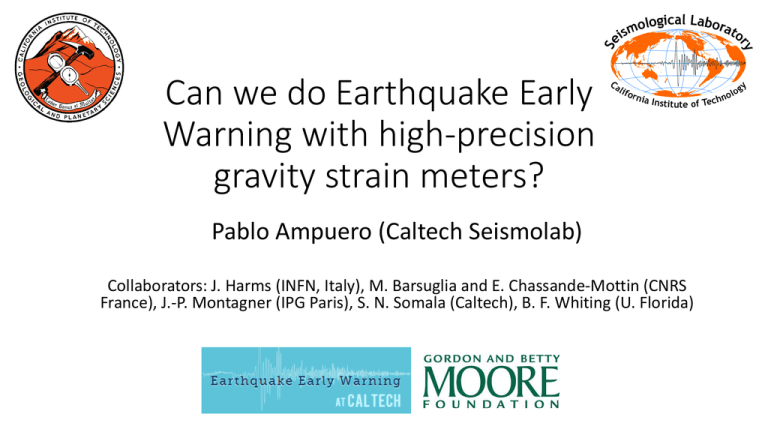Can we do Earthquake Early Warning with high
advertisement

Can we do Earthquake Early Warning with high-precision gravity strain meters? Pablo Ampuero (Caltech Seismolab) Collaborators: J. Harms (INFN, Italy), M. Barsuglia and E. Chassande-Mottin (CNRS France), J.-P. Montagner (IPG Paris), S. N. Somala (Caltech), B. F. Whiting (U. Florida) A multi-disciplinary, international collaboration: J. Harms (INFN, Italy) M. Barsuglia (CNRS France) E. Chassande-Mottin (CNRS) J.-P. Montagner (IPG Paris) S. N. Somala (Caltech) B. F. Whiting (U. Florida) Overview • Earthquake Early Warning Systems: current principles and limitations • Gravity perturbations induced by earthquakes • Gravitational Wave detectors: current and future capabilities • Potential capabilities of an EEWS based on gravity sensors Mainly based on: Harms, Ampuero, Barsuglia, Chassande-Mottin, Montagner, Somala and Whiting (2014), Prompt earthquake detection with high-precision gravity strain meters, manuscript submitted to J. Geophys. Res., available at http://web.gps.caltech.edu/~ampuero/publications.html Why do we need Early Warning ? Expected ground shaking in the Los Angeles basin, if we had an earthquake of magnitude M6.5 magnitude M7.0 4 Los Angeles Böse et al., in prep. Probabilities of events that would cause at least strong shaking (MMI≥VI) in the Los Angeles basin What is Earthquake Early Warning ? ability to provide a few to tens of seconds of warning before damaging seismic waves arrive seismogram P-wave • fast • not damaging S-wave • slow • damaging 5 Where is Early Warning used ? Romania Taiwan Turkey Italy Japan Operational systems Systems under development Mexico California Greece India Earthquake Early Warning Demonstration System How can we use Early Warning ? 1. Public Alert • warn people to take protective measures (drop-cover-hold on) • move people to safe positions • prepare physically and psychologically for the impending shaking 2. Trigger Automatic Responses • • • • • slow down/stop trains control traffic by turning signals red on bridges, freeway entrances close valves and pipelines stop elevators save vital computer information Limitations: • chance of false/wrong alerts: need to account for finite rupture size • no warning in blind zone (~30 km around epicenter) 7 Arrays Networked to Track Sources a network of high-frequency seismic arrays that will image large earthquakes with 10-fold better resolution than current seismic networks Multiple small-aperture arrays with overlapping fields of view covering a set of faults Exploit high-frequency waves (10 Hz) to achieve high resolution of rupture processes ANTS - Pablo Ampuero - Caltech Seismo Lab The blind zone of an EEWS Blind zone size in California (Kuyuk and Allen, 2013) • Blind zone = region close to the earthquake epicenter where damaging waves arrive before the warning is declared • Size of the blind zone = distance travelled by S waves at the time the 4th seismometer detects shaking + signal processing time + communication delays • Can we use geophysical signals that travel faster than seismic waves? Static gravity changes induced by earthquakes • GRACE / GOCE satellite mission have measure gravity changes after vs before large earthquakes • Those are STATIC gravity changes • Mention Kamioka superconducting gravimeter Matsuo and Heki (2011) Dynamic gravity changes induced by earthquakes: theory Gravity perturbation (acceleration) is related to a potential 𝛿𝑎 = −𝛻𝜓 that satisfies a Poisson’s equation 𝛻 2 𝜓 = −4𝜋𝐺 𝛿𝜌 The density perturbation induced by the seismic deformation is Assume point-source earthquake in an infinite elastic medium (ignore free surface effects): use known analytical solutions for the induced seismic displacement field 𝜉 𝑟, 𝑡 Dynamic gravity changes induced by earthquakes: theory We find that the perturbation of the gravity potential is Distance Gravity strain acceleration: Radiation pattern Double integral of seismic moment Verification: comparison to numerical simulation We implemented finite kinematic sources and computation of gravity field in the 3D spectral element program SPECFEM3D We find that errors are smaller than 5% http://geodynamics.org/cig/software/specfem3d/ Verification: comparison to numerical simulation We implemented finite kinematic sources and computation of gravity field in the 3D spectral element program SPECFEM3D http://geodynamics.org/cig/software/specfem3d/ The signal decays as 1/𝑟 5 , as predicted, even for dipping faults Earthquake spectra compared to gravity sensitivity Gravity strain acceleration: Relation to moment rate function: 𝑑5ℎ ∝ 𝑀0 (𝑡) 𝑑𝑡 5 Epicentral distance = 70 km Gravitational wave detectors Devices designed to measure gravitational waves, minute distortions of space-time that are predicted by Einstein's theory of general relativity GW: new way to study the universe Ex: VIRGO, LIGO projects to observe GW of cosmic origin (Laser Interferometer GravitationalWave Observatory) Gravitational wave detectors Devices designed to measure gravitational waves, minute distortions of space-time that are predicted by Einstein's theory of general relativity Ex: TOBA TOBA concept (torsional bar antenna) Gravitational wave detectors Devices designed to measure gravitational waves, minute distortions of space-time that are predicted by Einstein's theory of general relativity Ex: TOBA TOBA concept (torsional bar antenna) Earthquake spectra compared to gravity sensitivity Gravity strain acceleration: Relation to moment rate function: 𝑑5ℎ ∝ 𝑀0 (𝑡) 𝑑𝑡 5 Epicentral distance = 70 km Signal to noise ratio Shortest period resolved Optimal matched filter detection (with prewhitening) Conclusions • Multidisciplinary research, from fundamental to applied, from paperand-pen to high-performance-computing and instrument design • Next generation GW detector technology can be useful in Earth science: potential contribution to Earthquake Early Warning Systems • Advantage over other EEWS approaches: reduces the blind zone Earthquake warning sooner and for all • To do: • develop signal detection pipeline and demonstrate its capabilities • Propose an optimal system • Theory: incorporate free surface effects, etc








